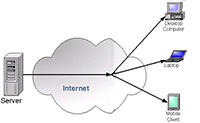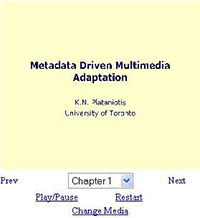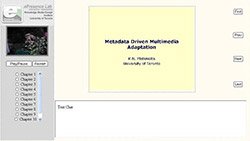Universal Multimedia Access in ePresence
The past few years have ushered society into a new digital multimedia information age. There is an ever-growing desire to gain access to information-rich multimedia content, anywhere and at anytime. Indeed, multimedia content is being both disseminated and consumed on a larger scale than ever before. Furthermore, collaborative applications such as Distance Learning (DL) have thrived given the technological advancements in end-user devices as well as the continued growth of the Internet. Users now require the ability to access multimedia seamlessly over heterogeneous networks and on virtually any type of terminal device. This need has spawned an initiative known as Universal Multimedia Access (UMA), which seeks to enable access to any multimedia information by any terminal over any network (Figure 1).
The Theme 3 research team within the NECTAR consortium aims to conduct further research within the rapidly growing area of DL, and more generally, interactive communication. The team explores both technical issues as well as HCI factors. One aspect of the research is concerned with the notion of a virtual classroom. The development of the virtual classroom is based on an existing software project, namely ePresence. Our project attempts to realize some of the goals envisioned for a UMA system which can be integrated within the ePresence architecture. Practically, the system provides users with a better quality service, by adapting both the multimedia content -- in this case, archived lectures from various universities, along with any accompanying slides -- as well as the screen layout to better meet their needs (see Figures 2 and 3). To use the system, a user must first create an account, during which the system will collect a list of preferences in terms of such characteristics as desired video size, frame rate, etc. Then, the system operates by processing this metadata, describing user environments, as well as metadata describing network conditions, to perform the aforementioned adaptation.
One of the major ways in which this system moves toward UMA is through the use of the current MPEG-21 Multimedia Framework standard, which is specifically designed to promote UMA. The metadata-based adaptation of content is achieved using ffmpeg, an open source tool which allows manipulation of media content. Note that other members of the NECTAR consortium are exploring in-house solutions of adaptation engines, which allowed this project to use the existing ffmpeg tool. The interface of the system is based on Java Server Page (JSP) technology. Combined with an Apache Tomcat Server, and MySQL backend, the result is a powerful ready-to-use system which effectively demonstrates the goals of future UMA systems in Distance Learning.
Team Members: Mazen Almaoui, Mohammed Ajmal, Rasha Rashidi, Stefan Gueorguiev, and Sabrina Liao
Related Publications:
- M. Almaoui, A. Kushki, K.N. Plataniotis, "Metadata Driven Multimedia Transcoding for Distance Learning," Springer/ACM Multimedia Systems Journal, vol. 12, no. 6, pp. 505-520, 2007.
- M. Almaoui, "Metadata Driven Multimedia Transcoding," M.A.Sc. thesis, University of Toronto, 2005.
- M. Almaoui, A. Kushki, K. N. Plataniotis, "Adaptive Multimedia Transcoding Using Cached XSLT Instances", in proceedings of 22nd Biennial Symposium on Communications, 2004.


